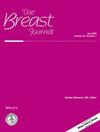Accuracy and Limitations of Sentinel Lymph Node Biopsy after Neoadjuvant Chemotherapy in Breast Cancer Patients with Positive Nodes
Abstract
Background. Axillary surgical management in patients with node-positive breast cancer at the time of diagnosis converted to negative nodes through neoadjuvant chemotherapy (NAC) remains unclear. Removal of more than two sentinel nodes (SLNs) in these patients may decrease the false negative rate (FNR) of sentinel lymph node biopsies (SLNBs). We aim to analyse the detection rate (DR) and the FNR of SLNB assessment according to the number of SLNs removed. Methods. A retrospective study was performed from October 2012 to December 2018. Patients with invasive breast cancer who had a clinically node-positive disease at diagnosis and with a complete axillary response after neoadjuvant chemotherapy were selected. Patients included underwent SLNB and axillary lymph node dissection (ALND) after NAC. The SLN was considered positive if any residual disease was detected. Descriptive statistics were used to describe the clinicopathologic features and the results of SLNB and ALND. The DR of SLNB was defined as the number of patients with successful identification of SLN. Presence of residual disease in ALND and negative SLN was considered false negative. Results. A total of 368 patients with invasive breast cancer who underwent surgery after complete NAC were studied. Of them, 85 patients met the eligibility criteria and were enrolled in the study. The mean age at diagnosis was 50.8 years. Systematic lymphadenectomy was performed in all patients, with an average of 10 lymph nodes removed. The DR of SLNB was 92.9%, and the FNR was 19.1. The median number of SLNs removed was 3, and at least, three SLNs were obtained in 42 patients (53.2%). When at least three sentinel nodes were removed, the FNR decreased to 8.7%. Conclusions. In this cohort, the SLN assessment was associated with an adequate DR and a high FNR. Removing three or more SLNs decreased the FNR from 19.1% to 8.7%. Complementary approaches may be considered for axillary lymph node staging after neoadjuvant chemotherapy. The study was approved by our institution’s ethics committee (Instituto de Investigacion Sanitaria Hospital 12 de Octubre (imas12), Universidad Complutense de Madrid, Madrid, Spain) (https://clinicaltrials.gov/ct2/show/NCEI:20/0048).


 求助内容:
求助内容: 应助结果提醒方式:
应助结果提醒方式:


